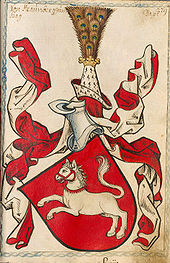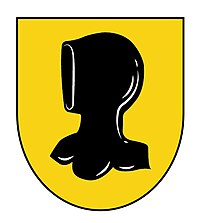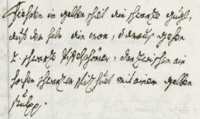Cooing (noble family)

The cooing (also Gurrn , in the singular of Gurre , the Gurr , the Gurrin ) are a Bavarian Uradelsgeschlechts . They are extinct today. There are three proven tribes of the cooing, the older cooing from Haag in Upper Bavaria (until 1245), the cooing from Regensburg (1440) and the younger cooing from Membach between Dachau, Aichach and Ingolstadt (1280–1517). The latter in particular administered large parts of what is now northern Upper Bavaria as secular and spiritual lords under the rule of the Wittelsbachers in the 14th and 15th centuries.
Similarities of the houses
The three tribes are temporally and / or spatially separated from one another. A direct connection can no longer be established, but can be accepted. Their common name and the territory in which they worked, the Duchy of Bavaria / Bavaria-Upper Bavaria / Bavaria-Munich, suggests that the Gurren have a common tribe. The Hague Gurren , also known as the Gurren von Mittelstetten , and the Regensburger Gurren have a white horse, "a white gurre", in their coat of arms. The coat of arms of the Gurren von Membach, Ebenhausen and Waal shows a black lamentation ball on a gold background.
Older Coo - The Coo of Hague
The Gurren family comes from Kirchdorf. The County of Hague took over in the 12th century. The progenitor is Konrad I, the Gurre. The rule of the Gurren over the county of Haag ends with the marriage of Sigfried von Frauenberg to the Gurrin Elisabeth von Haag in 1245. Due to this marriage Siegfried von Frauenberg inherited the possessions of the Lords of Haag and received them from Emperor Friedrich II. In 1245 the high jurisdiction .
ancestry
According to legend, the last Gurrin from Haag, Elisabeth, descends from Kuno Maier from Altdorf, the legacy of the Rott am Inn monastery (founded in 1081). The close connection between the Gurren and the monastery in Rott existed until 1245.
| Father Konrad Gurre von Kirchdorf (1100–1150) | ||||||||||||||||
| Konrad I., Gurre von Kirchdorf (approx. 1120–1180) | ||||||||||||||||
| Konrad II., Gurre von Haag (approx. 1150–1210) | ||||||||||||||||
| Noble von Haag | ||||||||||||||||
| Elisabeth, Gurrin von Haag (–1247) | ||||||||||||||||
| Gertrud von Preysing | ||||||||||||||||
coat of arms
By marrying in, the lords of Frauenberg became lords of the county of Haag. They adopted the coat of arms of the coo, a white gurre in the bridle, into their own and still wear it today.
Coo from Regensburg
Just like the Gurren von Haag, the house of the Gurren zu Regensburg had a white horse in their coat of arms. The cooing from Regensburg only appeared in the 15th century. They include the brothers Hans , Andreas and Berthold , who is a carer in Triftlfing . They can be found in the handwritten notes of Johann Michael Wilhelm von Prey (1740). Their possessions reach as far as the Ilm, where they are mentioned in documents from around 1440. A descendant of the Regensburg Gurren was also Nikolaus Gurr zu Altmannstein (1469) and Kelheim (1486).
Where this part of the Gurren family comes from is completely in the dark. It is also not possible to establish a family relationship with the other two Gurren families.
Younger cooers - The cooers from Membach, Ebenhausen and Waal
According to its name, the places of activity of this house were the Upper Bavarian Ebenhausen (today: Baar-Ebenhausen ), "Waldt" (today Waal bei Rohrbach ) and Membach bei Aichach, of which the exact location is not known. Of all cooing, the genealogy of the Membacher is best passed down. The handwritten notes of Franz Freiherr von Eckher (1695) and Johann Michael Wilhelm von Prey (1740) contributed significantly to this . The records of the Gurren in the area south of Ingolstadt show that the family were closely connected to many of the local noble families, such as the Schilwazen , the von Hexenagger, the Hausner or the von Weichs .
Beginning of the Gurr von Membach family
The first Gurr von Membach that can still be identified today was Ulrich, who married Odilia von Sandizell around 1320 . He is listed in the genealogical works of Eckher and Prey as the first of the Gurren von Membach, Ebenhausen, Waldt . All cooing of this house come directly from Ulrich. Who is the true progenitor of the Membacher family and how their connection to the Hague Coos is shaped is unknown today.
Ulrich Gurr von Membach in turn has a son Ulrich, who lives in Volkersdorf near Jetzendorf . He married Haylbig von Weichs around 1350. He is followed by his sons Hans, Konrad and Peter. These are located in the area between Ingolstadt and Munich, such as Konrad Gurr zu Ebenhausen, who is mentioned in documents from Geisenfeld Monastery in 1380. You take on administrative tasks: for example, Peter Gurr von Membach is a district judge in Dachau .
High phase of the house
Eberhard Gurr zu Membach (born around 1385) emerged from the marriage of Peter dem Gurren zu Dachau with Helena von Salldorf (1383). In 1424 he married Dorothea Hausner von Freinhausen, a representative of a branched dynasty from the Paartal. The children of the marriage of Eberhard and Dorothea, namely Kaspar , Ulrich and Diepold , held high offices in the medieval centers of Paar and Ilm in the 15th century.
- Kaspar Gurr (approx. 1430–1491; see pedigree) is a judge in Hohenwart. Through his marriage to Sarah von Sandizell, he renewed the union with the noble house from the Schrobenhausen region. His daughter Barbara joins the Order of Hohenwart . Anna Gurr and Ludwig Gurr emerge from the second marriage (Barbara, no affiliation known). The latter becomes a chaplain in Hohenwart. Anna Gurrin von Membach becomes a nun in the Benidictine convent in Neuburg , where she later holds the office of abbess.
- Ulrich Gurr zu Waal ("Waldt", approx. 1425–1471) can be found in Duke Albrecht's land table Pfaffenhofen court. He died young and, like his wife Katharina Hinterskircher (died 1450), was buried with the Franciscans in Ingolstadt .
- Diepolt Theobalt Gurr zu Geisenfeld ("Geysenfeldt", approx. 1430–1493) is a judge in Scheyern , among others . Together with his brother Kaspar, he manages the family's property in the Ilmtal (including the Grasslhof in Walkersbach ). In 1454 he married Regina Abensdorfer.

| Ulrich Gurr zu Volkersdorf (approx. 1290–1360) | ||||||||||||||||
| Peter Gurr zu Dachau (approx. 1350-1420) | ||||||||||||||||
| Haylbig von Weichs (go. 1350) | ||||||||||||||||
| Eberhard Gurr zu Membach (approx. 1385–1450) | ||||||||||||||||
| Stephan von Salldorf | ||||||||||||||||
| Helena von Salldorf, (died 1383) | ||||||||||||||||
| Anna von Achdorf zu Helffenbrunn (gone 1366) | ||||||||||||||||
| Kaspar Gurr zu Hohenwart (approx. 1430–1491) | ||||||||||||||||
| Liebhart Hausner von Freinhausen | ||||||||||||||||
| Erasmus Hausner von Freinhausen | ||||||||||||||||
| Ursula von Rohrbach (died 1374) | ||||||||||||||||
| Dorothea Hausner von Freinhausen (died 1424) | ||||||||||||||||
| Ulrich Hausner from Steppberg | ||||||||||||||||
| Barbara Hausner von Steppberg (go. 1403) | ||||||||||||||||
| Elisabeth Weißenfelder (died 1363) | ||||||||||||||||
Extinction of the male line
Anna Gurr, Abbess in Neuburg, in primary sources verifiably the daughter of Kaspar Gurr, is the last of the Gurren to hold a powerful office. After the confusion in the Landshut War of Succession , Gurrin Anna was replaced as abbess by Margarete von Bayern in 1509 . Margarete thus escapes a church ban in the course of power games in the context of the Wittelsbach succession. Anna Gurr von Membach died in the monastery in 1517. With it, the power of the younger cooing dried up in the south of Ingolstadt. Because the descendants of the other cooing do not produce male offspring either, the cooing house in the male line died out at the beginning of the 16th century.
Individual evidence
- ↑ Rudolf Münch: The big book of the county of Haag. Volume I. Prehistoric times to the Middle Ages . History Association of the Reichsgrafschaft Haag eV, 1997, p. 34f.
- ↑ Rudolf Münch: The big book of the county of Haag. Volume I. Prehistoric times to the Middle Ages . History Association of the Reichsgrafschaft Haag eV, 1997, p. 34f.
- ^ Hermann Schwarzmeier: Rohrbach. Volume II. Hermann Schwarzmeier and the Rohrbach community, 2016, district: Waal
- ^ Franz Freiherr von Eckher: Alphabetical collection on the genealogy of the Bavarian nobility Freising, 1695
- ^ Johann Michael Wilhelm von Prey: Collection on the Genealogy of the Bavarian Nobility, in alphabetical order Freising, 1740
- ↑ Michael Trost: History of the Geisenfeld market . Munich 1877, p. 108
- ^ Max Freiherr von Freyberg: Collection of historical writings and documents: Geschöpft aus Handschriften, Volume 3, 1830. P. 348, restricted preview
- ^ Max Freiherr von Freyberg: Collection of historical writings and documents: Created from manuscripts. Volume III. , 1830, page 348
- ↑ Document 300th Benedictine monastery Neuburg documents (1259-1584) , April 29, 1487
literature
- Johannes Goldner, Wilfried Bahnmüller: Early Bavarian noble families , Freilassing 1985, ISBN 3-7897-0123-8




